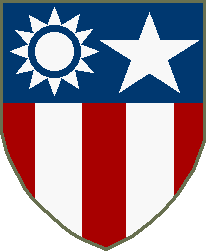
|
China-Burma-India Theater of World War II
Norman A. H. Carlile was one of several former 316th Infantry officers who saw service in China. Major Carlile was assigned to the 316th Infantry on 8 June 1934, as a graduate of the ROTC of Lehigh University, Bethlehem, PA. On 2 July 1937, he was relieved from the 316th Infantry, having moved from the Regimental area. He was ordered to Active Duty 27 January 1942, as a 1st Lieutenant and sent to the Infantry School at Fort Benning, GA for the Rifle and Heavy Weapons Company Course. He was then sent to Camp Croft, SC, assigned as a Platoon Leader, Co. A, 31st Infantry Training Bn., 9th Infantry Training Regiment. Soon after he became Executive Officer of Co. A.
On 24 December 1942 he was promoted to Captain.
On 4 February he was assigned as S-4 and Police and Prison Officer of the 9th Infantry Training Regiment.
On 1 May 1943 he was sent to the Military Intelligence School at Yale University, where he studied the Chinese language.
|
|
Elvis J Stahr, Jr. is in the middle of the next row from the top. Stahr became Secretary of the Army under President Kennedy. |
On 31 August 1943, he received his overseas orders, sailing from the Port of Embarkation, Patrick Henry, VA on 23 October 1943 for Oran, Algeria.
On 3 January 1944, he sailed via the Mediterranean and the Suez Canal - to Bombay, India and thence by train to Calcutta and the Replacement Center at Angus Mills.
Here he learned that he was to be assigned to Z-Force, Kweilin, China.
|
| In Egypt on the way to China. Norman Carlile is at right. |
Captain Carlile traveled by boat up the Brahmaputra River and then by train to Chabua, Assam. On 3 April 1944, he flew over the Hump in a C-46 to Kunming, China. Upon arrival, he found that had been reassigned to Y-Force and ordered to the Infantry Training Center at Kunming to familiarize himself with Chinese weapons. On 21 April 1944 he was sent to the 200th Chinese Division where he was placed in charge of training a Chinese regiment.
He was transferred on 18 May 1944, to the 69th Composite Wing at Yunanni for training as an Air-Ground Liaison Officer.
Soon after this, on 25 May, 1944, he left for the Salween River, where he joined the 28th Chinese Division as their "Air Party."
The 28th Chinese Division had been given the mission of driving the enemy from positions on Hsung-Shan, an elevation from which the Japanese could observe the site of a Burma Road bridge over the Salween River and so prevent its rebuilding.
During the fighting, Captain Carlile obtained supplies for the Chinese by air-drop and also secured air support.
|
We then moved to Lungling. Here the Japs not only occupied the city but also a long high ridge overlooking the city. Two Chinese divisions had been well shot up trying unsuccessfully to drive the Japs off the ridge. The 28th Division got the job and we moved into position early in August. After several weeks of preparation, we attacked and, a week later, occupied the ridge. Although only a few hundred officers and men were left in the division, they held the ridge against counter attacks for two weeks until relieved.
His experiences were varied to say the least. Always the hardships were minimized or made a joke of; the perils of combat rarely mentioned at all: I am getting used to living conditions, they seem normal now. I ll have to be re-civilized when I get back. One morning I woke up at 4:30 and found I was sleeping in a lake. The place I was in had a water channel in it that I did not know about and when it started pouring, the place filled with water. Things are going fine and I am enjoying myself despite the inconveniences. I use chopsticks exclusively now. I have a variety great variety of living quarters too barracks, hotels, temples, mud huts, stables, mud puddles and so on. The rains make things a bit bad now, but I am doing all right.
On 20 December, 1944 he received his promotion to Major. After the Salween campaign, Major Carlile was assigned to a small American task force to go behind Japanese lines in East China. Later he was assigned to the 45th Chinese Division. At this time the division was engaged in preventing the Japs from moving up the Red River toward Kunming.
In March 1945, the 45th Chinese Division was chosen as one of the 36 American sponsored Divisions, moved back to Kunming to receive American weapons, equipment and training. April 1945, he became commanding officer of the U. S. Detachment.
|
On 3 July 1945 he was ordered to the U.S., flying from Kunming to Chabua and then to Agra and Karachi, India.
He then flew by Abadan, Cairo, Tunis and Casablanca to the Azores, Bermuda and New York.
While on leave, V-J Day arrived, and Major Carlile s orders to report to Camp Blanding, Florida were revoked.
He separated from the service 24 November 1945.

|

Major Norman A. H. Carlile
China-Burma-India Theater of World War II
Information from Regimental History of the 316th Infantry, Volume III
Shared by Jim Carlile
TOP OF PAGE ABOUT THIS PAGE CLOSE THIS WINDOW
VISITORS
Copyright © 2016 Jim Carlile
Adapted by Carl W. Weidenburner
Shown at left is Special Breast Order of Yun Hui with ribbon (Cloud and Banner - 6th class)
Awarded to Major Carlile




